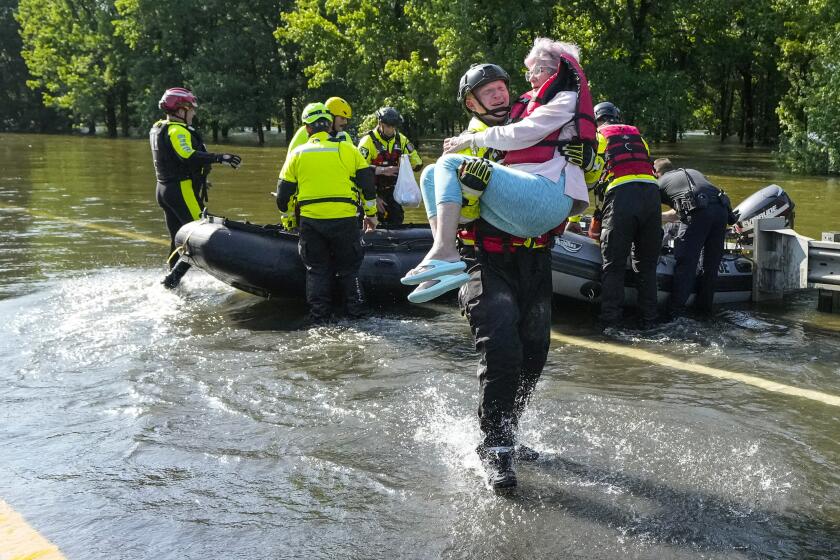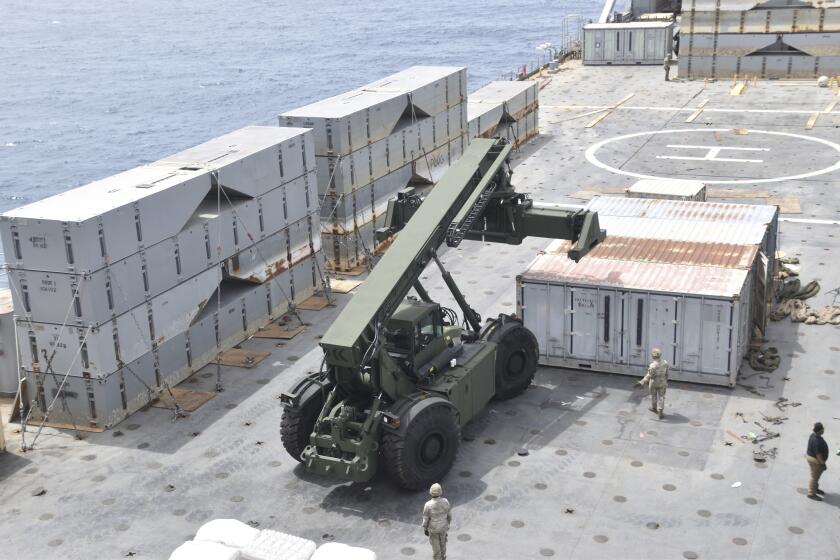Cocaine Crackdown Has Colombians Fearing War
Coca farmer Jose Manoma understands the fury behind the guerrilla offensive that has killed at least 130 Colombians and paralyzed half the country in the last three weeks.
His 15-acre field of coca, the leaf that produces cocaine, has been sprayed with defoliant twice this month as part of a U.S.-backed drug eradication program. While leftist guerrillas supporting the coca farmers have blown up pipelines, attacked army bases and blocked roads--halting overland transportation in about half of Colombia’s 32 provinces--Manoma and other growers have tried to negotiate a solution with a government commission in this provincial capital.
They have gotten no results. The government has refused to stop defoliation, turned down the growers’ offer to eradicate their own crops for a fee and rejected requests for price guarantees on alternative crops, he said.
“We would like to get out of coca,” said Manoma, a 44-year-old former construction worker. “But we cannot tear down one house without having another. I am the father of five children. I need to buy them food and clothing and send them to school. I have no market for yucca or corn.”
So he grows coca.
Manoma and his neighbors in Miraflores--widely recognized as the most important growing region in the top coca-growing province of Guaviare--say the government is not offering any serious alternatives. Meanwhile, many Colombians fear that the eradication program that has drawn this nation’s largest guerrilla group to openly support coca growers will lead their country into a civil war.
Nevertheless, Defense Minister Juan Carlos Esguerra vows that the eradication will not stop.
“We will not be moved,” he said. “Every day it is more clear that what we are up against with narcotics trafficking is a costly, difficult, hard and long struggle because we are talking about a powerful enemy. . . . But we are going to keep it up until we finish them off and we win.”
*
Guaviare is the front line of that struggle. The province has been under virtual military rule since it was declared a “public order zone” four months ago. Besides intensifying coca crop spraying, the government has blocked Guaviare’s supplies of cement and gasoline--which farmers use to turn coca leaves into a compact paste before selling it to merchants who refine the base into cocaine.
In response, an estimated 60,000 coca farmers in Guaviare and two neighboring coca-growing provinces worried that their regions will be the next public order zones have staged violent protests in several provincial towns. To support them, the Colombia Revolutionary Armed Forces, a guerrilla group known by its Spanish initials, FARC, has launched Colombia’s most violent offensive this decade.
The guerrillas are holding hostage 67 soldiers captured during an Aug. 30 raid on a jungle army base in which more than 30 soldiers were killed. By torching any traffic that moves on a spreading network of highways, they have cut off food supplies and driven up the price of vegetables and other perishable items in the capital, Bogota, and other cities.
The governor of Putumayo, a nearby coca-growing province, said earlier this month that his capital is under siege and could be attacked by guerrillas.
“This offensive has taken a lot of planning,” said Alfredo Molano, an expert on guerrilla activities. “This was not thrown together in a couple of weeks.”
Many Colombians worry that with its crackdown on coca growers--part of an overall strategy against narcotics that also includes arresting top international traffickers--their government has wakened a sleeping dog. The guerrillas that had mainly confined themselves to kidnapping, “taxing” and occasional raids on police stations in the regions under their control have come out of the jungle in a dramatic show of strength.
“We must have touched their interests deeply to have produced such a violent reaction,” Esguerra said.
FARC is widely believed to receive more than half its revenue from cocaine-related “taxes” on large growers, merchants, laboratories and airplanes that transport cocaine. Many experts believe that its members are even more deeply involved: guarding fields, operating laboratories and even running export routes.
FARC operates a route that begins in San Jose del Guaviare and ends in Port-au-Prince, Haiti, where Mexican middlemen take over and send the cocaine to the United States, according to Fabio Castillo, one of Colombia’s top investigative reporters and the author of several books on the drug trade.
*
Molano scoffs at the notion that FARC--a rural guerrilla movement--is sophisticated enough in international travel and marketing to run such an operation. But whatever its level of involvement, army commander Harold Bedoya estimated that since the public order zone was declared, FARC has lost $15 million in income and an additional $48.6 million in destroyed or confiscated cocaine raw materials, equipment and airstrips.
“It’s hurting these guys, otherwise they wouldn’t be yelling and screaming,” said U.S. Ambassador to Colombia Myles Frechette, one of the eradication program’s few fans in Colombia. “We want them to eradicate. That is still part of U.S. policy.”
The United States is urging Colombia to step up the program by switching from a liquid defoliant to a more toxic granular herbicide that attacks the roots of plants as well as the leaves.
Eradication is one of the scarce areas of cooperation in a U.S.-Colombian relationship that reached its lowest point in decades this summer, after President Ernesto Samper became the first sitting president in Latin American history to lose his U.S. visa. It was revoked because of evidence that his 1994 campaign was partly financed by millions of dollars in drug money.
Indications are that the eradication program is effective, but at a high cost for the most vulnerable link in the cocaine chain: the peasant farmers who grow coca.
“Fumigating the crop does not affect the big drug bosses,” said Armando Borrero, a former national security advisor. “It affects peasant farmers and the FARC. The capos just import more base from Bolivia. If production drops, they raise the price.”
During their 28 years of marriage, Celina Martinez and her husband, Felix, have grown corn, cotton, bananas and marijuana to try to scratch out a living in the jungle about a mile downriver from San Jose del Guaviare. Most recently, they planted coca bushes in a clearing about the size of a baseball diamond.
*
On the ground, the bushes are hidden by dense jungle growth. But that did not hide them from the crop-dusting planes that take off from the anti-narcotics police base here. A few bushes survived the eradication effort, Martinez said, showing them to a visitor, mainly as a joke.
“With the price of gasoline and cement so high, it’s not worthwhile to make [cocaine] base,” she said. She does not bother to explain that gasoline now costs $26 a gallon on the black market because the army restricts its sale because it is used to make cocaine base.
Without a coca crop, her husband cleared another patch of jungle and is planting cotton on the burned-out remains of the trees that used to grow there. Cotton prices are relatively strong now, but Martinez said she worries how high they will be once the cotton is picked--a concern she did not have about coca because prices were guaranteed, she said.
Martinez has not gotten rich from cocaine. She wears a worn blouse and skirt, and rubber boots cover her bare feet. Her wood-plank house consists of a single bedroom with hammocks and a covered walkway big enough for a rough wooden table and chairs. The walkway leads to a dirt-floor kitchen where she cooks over an open flame.
One of the sad ironies is that coca growers make so little from a crop that is the base of such a lucrative business, said Hector Moreno, director of a year-old government program charged with finding alternatives for the farmers.
“If the cocaine industry were an ear of corn, what coca farmers get is barely a kernel,” he said. He estimates that the net profit from a 2.5-acre coca harvest--of which there are up to three annually--equals about 1 1/2 months of the minimum wage, or about $1,150. “We can match that with legal crops,” he said.
To attract farmers to the program, Moreno said, he needs to offer financing and stable prices. According to his estimates, that will cost a minimum of $334 million over four years.
Less than one-tenth of that amount was spent in the program’s first year. To complicate matters, the $184 million in international aid that Colombia had expected to receive for the program has not materialized.
As a result, coca growers joke about the program. Further, the program helps only coca farmers who cultivate seven acres or fewer. That covers an estimated 60% of Colombia’s coca crop, but it does not help Manoma.
“I went to Miraflores with the idea of farming,” he said. “I started to plant yucca and corn and saw that it was not productive.” Even the local police told him that in order to survive, he had to grow coca, he recalled. That was 18 years ago.
Even if the government could find a crop for the farmers, it would still have to find employment for the thousands of leaf pickers, Borrero warned. Low prices for coffee and cotton have driven migrant farm workers into the cocaine fields in search of work.
There, they develop aspirations that would never have occurred to them picking other crops. Oscar Sena, 39, worked for three years as a leaf picker in Miraflores and saved enough money to buy his own small farm in 1992. Now he grows cocaine there.
“They think they can starve us out, but we have no place else to go,” he said. “They are going to find out that we will not let them.”
More to Read
Start your day right
Sign up for Essential California for news, features and recommendations from the L.A. Times and beyond in your inbox six days a week.
You may occasionally receive promotional content from the Los Angeles Times.






